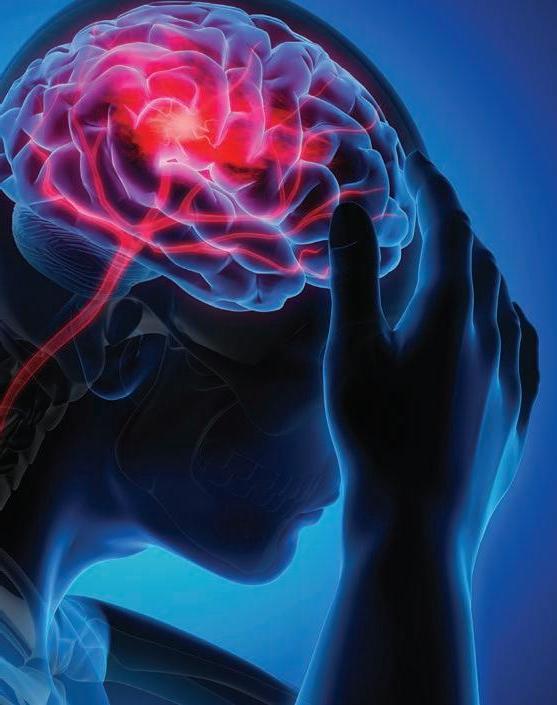
6 minute read
STROKE



GET HEALTHY to reduce stroke risk




A staggering one in four adults will have a stroke of some kind in their lifetime, but with improved awareness of this medical tatistics from the World Stroke Organization show that strokes are the leading cause of disability worldwide and the second-leading cause of death. A stroke occurs when a blood vessel carrying oxygen and nutrient-rich blood to the brain either suddenly gets blocked or bursts. This results in damage s condition, many could be prevented. By Prof Andre Mochan to cells in that part of the brain, which then leads to the symptoms and signs of stroke.
Stroke is very similar to what happens to the heart during a heart attack and is therefore aptly referred to as a “brain attack”. What is important to note, and is not widely realised, is that most strokes can be prevented by leading a healthy life, and treating and managing risk factors like high blood pressure, cholesterol and diabetes in association with your doctor.
PREVENTION BETTER THAN CURE
This year’s slogan for World Stroke Day on 29 October was “Join the movement”, encouraging individuals to be more physically active in order to reduce their risk of stroke. When considering the global burden of stroke, the most effective and important health intervention is prevention, or what is called primary prevention, of a first stroke. Firstly, this entails changing from an unhealthy sedentary lifestyle to a healthy one including measured physical
Prof Mochan activity or exercise, following a balanced diet and not smoking. Secondly, it entails awareness of and treatment for any major stroke risk factors you may have, most notably hypertension (high blood pressure), diabetes and high cholesterol.
By following these measures, both brain and heart attack risks are mitigated, and a healthy vascular system is promoted. Up to 90 per cent of strokes could be prevented by addressing a small number of risk factors, including hypertension, diet, smoking and exercise. Other risk factors to be aware of include age (with individuals older than 55 at higher risk), male gender and a family history of stroke.
FAST FACT: In South Africa about 240 people have a stroke every day, almost 70 of which are fatal, according to the Heart and Stroke Foundation South Africa.

Preventive action would contribute to a massive reduction in stroke and would also contribute to global goals of reducing cardiovascular disease, cancer, diabetes and other significant causes of death and suffering worldwide.

KNOWLEDGE IS POWER
Another very important pillar to reduce stroke-related long-term disability or death is stroke awareness. If people are empowered with knowledge of the signs of stroke, they become more alert and will act to seek emergency medical treatment as quickly as possible. The best treatment outcomes for the most common type of stroke are usually obtained if appropriate treatment is provided within four-and-a-half hours of the onset of a stroke, so time is of the essence. Prompt treatment can either reverse the stroke or at least reduce resulting disability, so you should not hesitate to call an emergency service provider should you suspect someone is having a stroke.
Many people expect the symptoms of a stroke to result in an individual’s dramatic collapse or a major seizure. This frequently results in a failure to recognise the signs of a stroke and to seek urgent treatment. Very often the first sign of stroke could be as subtle as only experiencing a weakness in an arm or down one side of the body, one side of the face sagging, or a severe headache.
Many survivors of stroke will have some form of disability or impairment. However, with appropriate acute treatment, rehabilitation and support, many stroke survivors can recover or at least be returned to maximum functioning and a meaningful life.
STROKE FACTS TYPES OF STROKE
There are two main types of strokes: ischaemic and haemorrhagic. An ischaemic stroke results from a halt in the supply of blood to a part of the brain as a result of a clot. Nearly nine out of 10 strokes are of this type. The latter type of stroke is caused by a haemorrhage in the blood vessels, causing bleeding into the brain. It occurs far less often than the ischaemic stroke but is usually more serious.
ASSESS YOUR RISK
The World Stroke Organization has endorsed a simple app called Stroke Riskometer, which is available on the App Store and Google Play Store. It is an easy-to-use tool for assessing your individual stroke risk and what you can do to reduce it.
REDUCE YOUR RISK
While some people have a higher risk of stroke, such as those who have a family history of the condition, everyone can take positive action to reduce their risk: • Switch to a low-fat, low-salt, high-fibre diet, and eat plenty of fruit and vegetables. • Lose weight if you are overweight. This will help reduce blood pressure and improve health. • Control blood pressure. High blood pressure increases the risk of stroke. • Control high cholesterol levels. • Exercising for about 40 minutes four times a week is recommended.
Regular exercise will also help control stress. • Pay attention to your blood pressure and take steps to keep it within acceptable limits. • Watch your cholesterol levels and make sure that they are not too high. • If you have diabetes, be sure that it is controlled in consultation with your doctor. • If you smoke or take drugs, it is strongly recommended that you stop doing so. If you drink alcohol, do so in moderation.
KNOW THE SIGNS AND SYMPTOMS
The symptoms of stroke can differ greatly depending on the type of stroke and which part of the brain has been affected. However, there are a number of common signs including: • Facial droop – can you get the person to smile, or do one or both sides of the face sag? • Weakness in the arms or legs – ask the patient to lift his or her arms in the air. Are they able to lift them both? • Weakness or numbness down one or both sides of the body. • Coordination and balancing problems – does the patient have difficulty walking or standing up? • Sudden vision changes, sometimes even blindness, in one or both eyes. • Abnormal speech – a person who has suffered a stroke may have difficulty speaking and slur their words, but also may have trouble understanding spoken language. • Sudden, severe headache with no known cause.
* Professor Andre Mochan is a neurologist at the Netcare Rehabilitation Hospital in Johannesburg and an expert in the rehabilitation of brain injuries, including those caused by strokes.








